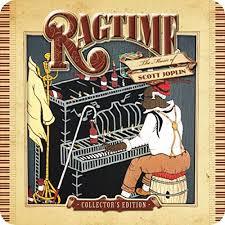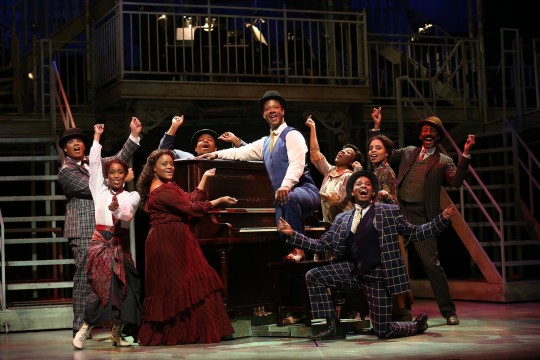#ALL COONS LOOK ALIKE TO ME - American Sheet Music
Explore tagged Tumblr posts
Text
ALL COONS LOOK ALIKE TO ME - American Sheet Music


From This Book

Click Here to Get The Book - FREE
#coons#white supremacy#sheet music#white american racism#ALL COONS LOOK ALIKE TO ME - American Sheet Music#Black Art Richard J Powell#Art Guides
14 notes
·
View notes
Photo


Ragtime originated in African American music in the late 19th century and descended from the jigs and march music played by African American bands, referred to as "jig piano" or "piano thumping".

By the start of the 20th century, it became widely popular throughout North America and was listened and danced to, performed, and written by people of many different subcultures. A distinctly American musical style, ragtime may be considered a synthesis of African syncopation and European classical music, especially the marches made popular by John Philip Sousa.
Some early piano rags are entitled marches, and "jig" and "rag" were used interchangeably in the mid-1890s.Ragtime was also preceded by its close relative the cakewalk. In 1895, African entertainer Ernest Hogan composed two of the earliest sheet music rags, one of which ("All Coons Look Alike to Me") eventually sold a million copies. The other composition was called "La Pas Ma La", and it was also a hit.
As African musician Tom Fletcher said, Hogan was the "first to put on paper the kind of rhythm that was being played by non-reading musicians." While the song's success helped introduce the country to ragtime rhythms, its use of racial slurs created a number of derogatory imitation tunes, known as "coon songs" because of their use of racist and stereotypical images of Africans. In Hogan's later years, he admitted shame and a sense of "race betrayal" from the song, while also expressing pride in helping bring ragtime to a larger audience.
The emergence of mature ragtime is usually dated to 1897, the year in which several important early rags were published. In 1899, Scott Joplin's "Maple Leaf Rag" was published and became a great hit and demonstrated more depth and sophistication than earlier ragtime. Ragtime was one of the main influences on the early development of jazz (along with the blues). Some artists, such as Jelly Roll Morton, were present and performed both ragtime and jazz styles during the period the two styles overlapped. He also incorporated the Spanish Tinge in his performances, which gave a habanera or tango rhythm to his music.��Jazz largely surpassed ragtime in mainstream popularity in the early 1920s, although ragtime compositions continue to be written up to the present, and periodic revivals of popular interest in ragtime occurred in the 1950s and the 1970s.
The heyday of ragtime occurred before sound recording was widely available. Like classical music, and unlike jazz, classical ragtime had and has primarily a written tradition, being distributed in sheet music rather than through recordings or by imitation of live performances. Ragtime music was also distributed via piano rolls for player pianos. A folk ragtime tradition also existed before and during the period of classical ragtime (a designation largely created by Scott Joplin's publisher John Stillwell Stark), manifesting itself mostly through string bands, banjo and mandolin clubs (which experienced a burst of popularity during the early 20th century) and the like.
A form known as novelty piano (or novelty ragtime) emerged as the traditional rag was fading in popularity. Where traditional ragtime depended on amateur pianists and sheet music sales, the novelty rag took advantage of new advances in piano-roll technology and the phonograph record to permit a more complex, pyrotechnic, performance-oriented style of rag to be heard. Chief among the novelty rag composers is Zez Confrey, whose "Kitten on the Keys" popularized the style in 1921.
Ragtime also served as the roots for stride piano, a more improvisational piano style popular in the 1920s and 1930s. Elements of ragtime found their way into much of the American popular music of the early 20th century. It also played a central role in the development of the musical style later referred to as Piedmont blues; indeed, much of the music played by such artists of the style as Reverend Gary Davis, Blind Boy Fuller, Elizabeth Cotten, and Etta Baker could be referred to as "ragtime guitar."
Although most ragtime was composed for piano, transcriptions for other instruments and ensembles are common, notably including Gunther Schuller's arrangements of Joplin's rags. Ragtime guitar continued to be popular into the 1930s, usually in the form of songs accompanied by skilled guitar work. Numerous records emanated from several labels, performed by Blind Blake, Blind Boy Fuller, Lemon Jefferson, and others. Occasionally ragtime was scored for ensembles (particularly dance bands and brass bands) similar to those of James Reese Europe or as songs like those written by Irving Berlin. Joplin had long-standing ambitions of synthesizing the worlds of ragtime and opera, to which end the opera Treemonisha was written. However, its first performance, poorly staged with Joplin accompanying on the piano, was "disastrous" and was never performed again in Joplin's lifetime.[The score was lost for decades, then rediscovered in 1970, and a fully orchestrated and staged performance took place in 1972. An earlier opera by Joplin, A Guest of Honor, has been lost
The rag was a modification of the march made popular by John Philip Sousa, with additional polyrhythms coming from African music.It was usually written in 2/4 or 4/4 time with a predominant left-hand pattern of bass notes on strong beats (beats 1 and 3) and chords on weak beats (beat 2 and 4) accompanying a syncopated melody in the right hand. According to some sources the name "ragtime" may come from the "ragged or syncopated rhythm" of the right hand. A rag written in 3/4 time is a "ragtime waltz."
European Classical composers were influenced by the form. The first contact with ragtime was probably at the Paris Exposition in 1900, one of the stages of the European tour of John Philip Sousa. The first notable classical composer to take a serious interest in ragtime was Antonín Dvořák.

French composer Claude Debussy emulated ragtime in three pieces for piano. The best-known remains the Golliwog's Cake Walk (from the 1908 Piano Suite Children's Corner). He later returned to the style with two preludes for piano: Minstrels, (1910) and General Lavine-excentric (from his 1913 Préludes), which was inspired by a Médrano circus clown
198 notes
·
View notes
Text
Ernest Hogan

Ernest Hogan was the first African-American entertainer to produce and star in a Broadway show (The Oyster Man in 1907) and helped to popularize the musical genre of ragtime.
He was born Ernest Reuben Crowders, in the Shake Rag District of Bowling Green, Kentucky, in 1865. Little to nothing is known about his childhood, but as a teenager, he traveled with a minstrel troupe called the Georgia Graduate, where he performed as a dancer, musician, and comedian. During this time he changed his name to Hogan because "Irish performers were in vogue." He would also claim that he took the name to honor a Judge Hogan of Bowling Green, for whom his mother had worked as a cook. A few years after changing his name to Hogan, Ernest starting finding success in solo acts in New York City. Hogan likely performed in blackface during this time, as he sometimes did later in his career.
In 1895 Hogan composed several popular songs, including "La Pas Ma La" and "All Coons Look Alike to Me". Hogan was evidently not the originator of the song's lyrics, having appropriated them after hearing a pianist in a Chicago salon playing a song titled "All Pimps Look Alike to Me" The success of the latter song created many derogatory imitations, known as "coon songs" because of their use of racist and stereotypical images of black people.
Hogan was considered one of the most talented performers and comedians of his day. His contribution to the racist "coon song" craze haunted him—before his death he stated that he regretted using the racial slur in his song.The use of the racial slur "coon" in the song infuriated many African Americans. Some black performers made a point of substituting the word "boys" for "coons" whenever they sang it. Ironically, the word "coon" was more socially acceptable than "pimp" among white audiences of the time.
The controversy over the song has, to some degree, caused Hogan to be overlooked as one of the originators of ragtime, which has been called the first truly American musical genre. Hogan's songs were among the first published ragtime songs and the first to use the term "rag" in their sheet music copy. While Hogan made no claims to having exclusively created ragtime, fellow black musician Tom Fletcher said Hogan was the "first to put on paper the kind of rhythm that was being played by non-reading musicians." When the ragtime championship was held as part of the 1900 World Competition in New York, semifinalists played Hogan's "All Coons Look Alike to Me" to prove their skill.
Ernest Hogan was believed to have been married twice. He was first wed to a youthful singer named Mattie Wilkes. She was a popular soprano who had been performing in vaudeville shows with him; they married around 1901 or 1902. Hogan was later reportedly married to a woman named Louise, who helped him organize concerts in the early 1900s. The specific dates of these marriages are not known; Hogan did not have children with either of his wives.
In January 1908, Hogan collapsed onstage in New York and again in Boston while performing in "The Oyster Man." Forced to leave the show, Hogan spent the remainder of his life trying but failing to recuperate. He died from tuberculosis in Lakewood, New Jersey, on May 20, 1909.
https://en.wikipedia.org/wiki/Ernest_Hogan
38 notes
·
View notes